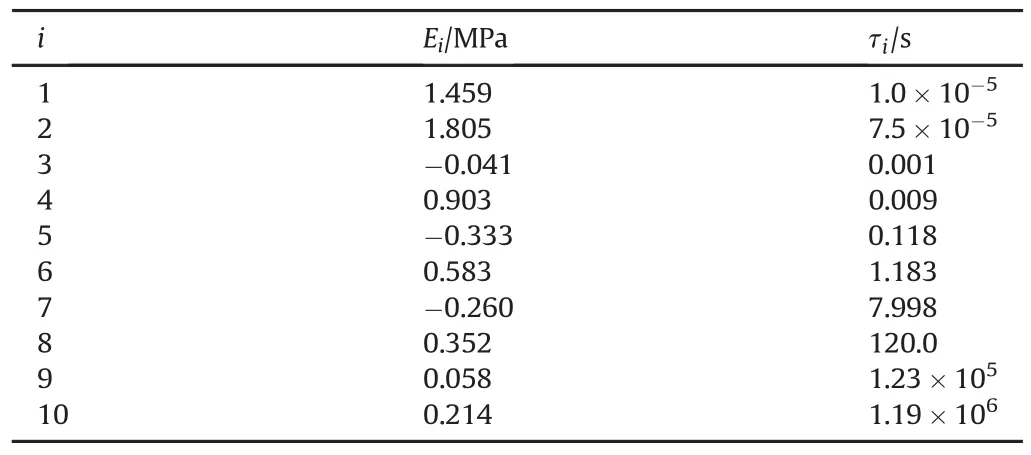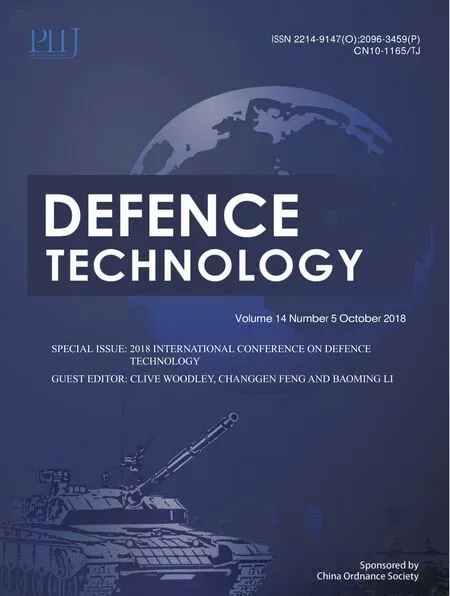Safety analysis on truing process of solid propellant
2018-10-18JunLiQingjieJioHuiRen
Jun Li,Qing-jie Jio,Hui Ren
aState Key Laboratory of Explosive Science and Technology,Beijing Institute of Technology,Beijing 100081,China
bScience and Technology on Aerospace Chemical Power Laboratory,Xiangyang 441003,China
Keywords:Solid propellant Truing process Safety Finite element method
ABSTRACT In order to investigate safety character of solid propellant,the truing process was analyzed by a thermal mechanical coupled finite element method.Based on the viscoelastic integral constitutive relation,the temperature response in truing process was calculated.The result showed that the maximum temperature in solid propellant truing process could attain up to 65oC when the truing velocity was 10 mm/s and the truing thickness was 1 mm,and there was no remarkable temperature change under the truing thickness of 1.0 mm,1.5 mm and 2.5 mm.The hazard in truing process of solid propellant was mainly close to the edge of cutting area.
1.Introduction
The purpose of solid propellant truing is elaborate shaping the solid propellant grain.However,great quantity of high energy materials(such as RDX,HMX etc)and various catalysts(such as ferrocene)used in high energetic solid propellants increased the hazardous property in the truing process.According to the result of international statistic analysis,the accident rate of solid propellant process was about 28%[1].Because too many complicate factors are involved in the safety of truing process of solid propellant,although a lot of work has been done to improve the inherent safety level in this process,the safety control in high energetic propellants truing is still dependent on experience of workers.No work has been tried to analyze the condition of solid propellant grain during truing process.
The objective of this paper is to analysis the truing process of solid propellant by finite element method,the temperature response of truing process under different thickness and velocity were calculated,the hazardous spots in truing process was found.
2.Computational model and numerical method
2.1.Thermal-viscoelastic constitutive equation
Solid propellant is a material filled with large amount of solid particles in matrix,the mechanical property has strong relationship to time and temperature,the incremental constitutive equation was supposed for convenience of calculation:(1)solid propellant is isotropy and physical linearity material;(2)concept of time temperature shift principle is used[2-6].
Where G(t)is shear slack variable,and K(t)is volume slack variable.The series can be written by the following formula:
Where t and τare equivalent time.αT is time-temperature equivalent factor,αT is calculated by the following W.L.F equation:
C1and C2for material constant are given by experiments,Trefis reference temperature.
2.2.Physical model and finite element mesh
The length and width of the test sample were 15 mm and 10mm,but the physical model of solid propellant truing was very simple,because the truing thickness was much less than the web of solid propellant.The cutter was simplified to a rigid body with no friction.Finite element mesh as shown in Fig.1.All parts use square elements,24000 elements are created for the propellant grain,and 25040 nodes are used.
2.3.Material property test of solid propellant and data processing
The uniaxial testing method is widely used to analyze the mechanical property of solid propellant,the dimensions of testing sample was 10 mm×10 mm×70mm,the tensile velocity was 100mm/min and the testing temperature was-40oC,-20oC,5oC,20oC,50oC,70oC.The test result by the uniaxial method as shown in Fig.2.The master curve of solid propellant at the reference temperature of 25oC after shifted as shown in Fig.3.The master curve was fitted by prony series could get the master relaxation modulus curve of solid propellant:
where the balanceable modulus Ee=0.9MPa,Eiwas given in Table 1.
2.4.Other material parameters
Other material parameters are shown in Table 2[6-8].
3.Numerical results and analysis
Finite element simulation results showed that the temperature of solid propellant reached balance state in short time(see Fig.4),when truing velocity was 1 mm/s,the maximum temperature was not in the edge of cutter,but the area close to the edge of cutter,for the friction between cutter and solid propellant scraps,moreover,the plastic deformation is one of the important reason for temperature raising,therefore,the area after the edge of cutter is hazardous area in the truing process of solid propellant.

Table 1 Parameters of prony progression of propellant.
To investigate the temperature under different truing velocity,the results of maximum temperature in truing process under the truing velocity 1mm/s,5 mm/s and 10mm/s with the thickness of 1.0 mm(see Fig.5).The maximum temperature of truing process increased gradually as the velocity increased[9].The temperature response was lower when truing velocity was 1 mm/s,but the maximum temperature reached 65oC when truing velocity was 10 mm/s.
The result of the highest temperature under the different thickness 1.0 mm,1.5 mm and 2.5 mm when the truing velocity was 1mm/s(in Fig.6).The maximum temperature increased with the different thickness in truing process,but it was not obvious,the discrepancy of truing temperature between the thickness of 1.0 mm and 2.5 mm was approximately 1oC.
4.Conclusions
(1)The maximum temperature in truing process of solid propellant increased with the truing velocity increasing.The
maximum temperature reached 65oC when the truing velocity was 10 mm/s.

Table 2 Material parameters of solid propellant.
(2)The maximum temperature in truing process of solid propellant has no remarkable change under the truing thickness of 1.0 mm,1.5 mm and 2.5 mm.
(3)The hazardous area in truing process of solid propellant was notin the edge of cutter,but the area mainlyclose to the edge of cutting area.
杂志排行
Defence Technology的其它文章
- GUIDE FOR AUTHORS
- A novel strategy of smart manipulation by micro-scale oscillatory networks of the reactionary zones for enhanced extreme thrust control of the next-generation solid propulsion systems
- Method of ballistic control and projectile rotation in a novel railgun
- Conceptual design of 2 MJ capacitive energy storage
- LTT switch unit for capacitive energy storages
- Ballistic model for the prediction of penetration depth and residual velocity in adobe:A new interpretation of the ballistic resistance of earthen masonry
